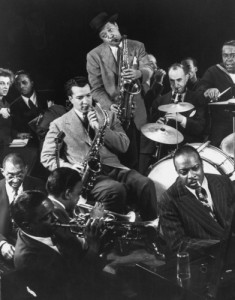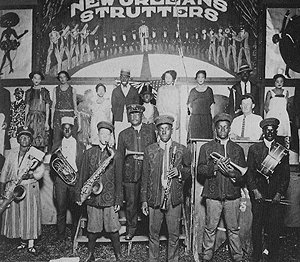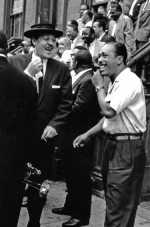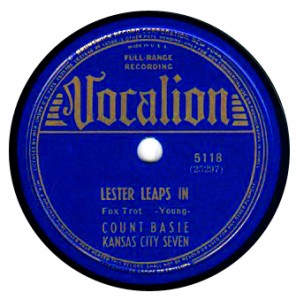
Young in 1943 jam session with Count Basie Band. Photo by Gjon Mili, courtesy The Jazz Image: Masters of Jazz Photography.
Lester Young is remembered as one of the jazz world's favorite Bohemians, but the originality of his tenor saxophone playing by far eclipsed his persona as a hipster.
He had definite ideas about his approach to jazz. He explained it this way. "Well, to my mind, the way I play, I try not to be a ‘repeater pencil,' ya dig? I'm always reaching. Originality's the thing. You can have tone, and technique, and a lot of other things, but without originality, you ain't really nowhere."
The C Melody saxophone—rarely heard today—was very popular in the 1920s. The acknowledged master of that instrument was Frank Trumbauer, a friend of Bix Beiderbecke. Lester Young talked about the influence that Trumbauer's playing had on his own sound on the lower-pitched tenor saxophone:
"Did you ever hear Frankie Trumbauer play "Singin' the Blues"? Heard that, and it tricked me—that's where I went. Trumbauer was always telling a little story like I liked to hear. He played the C Melody saxophone. So I tried to get that C Melody sound out of my tenor. That's why I don't sound like other people."

Young family band, New Orleans Strutters, 1924. Lester in center. Courtesy Institute Jazz Studies, Rutgers University.
After several years of touring with his abusive father's family band, Lester went out on his own. He was pulled into the orbit of the Blue Devils, the legendary Southwestern 'territory' band that settled in Kansas City and evolved into Bennie Moten's and then Count Basie's first band.
Young joined Count Basie in Kansas City in February 1936, and by the following fall they were in the recording studio. Lester had never made any recordings, though he'd been a working musician for sixteen years. The records Young made with Basie, and later with Billie Holiday, are now widely regarded as essential documents of 20th century music. An entire generation of saxophonists followed in his stylistic footsteps, among them Al Cohn, Zoot Sims, Stan Getz, Gerry Mulligan and Paul Desmond, to name but a few. And there is a clear influence of Lester Young's musical concept to be heard in the early playing of Charlie Parker.

Lester Young with Basie Orchestra 1939 World's Fair SF. Courtesy Institute Jazz Studies, Rutgers University.
Billie Holiday and Lester Young were soul mates in their approach to life and
music, though their relationship, by many accounts, was platonic. It was Billie who gave him his famous nickname, "Prez."
"The greatest man around in those days was Franklin D. Roosevelt, so I started calling Lester 'The President.' He called me 'Lady' and my mother was 'Duchess.' We were 'The Royal Family of Harlem.'
This week on Riverwalk Jazz Vernel Bagneris and Topsy Chapman paint a picture of Lester Young's life based on his own first-person accounts and those of musicians who knew him. The Jim Cullum Jazz Band, with tenor saxophonists Brian Ogilvie and Ron Hockett, offer their homage to the 'President of Tenor Sax.'
Special thanks to Nat Hentoff for permission to use excerpts from his interview with Lester Young, published in The Jazz Makers in 1957, as source material for first-person accounts in this script.
Photo credit for home page teaser image: Sax man Lester Young. Photo University Missouri, Kansas City
Text based on Riverwalk Jazz script by Margaret Moos Pick ©2011




